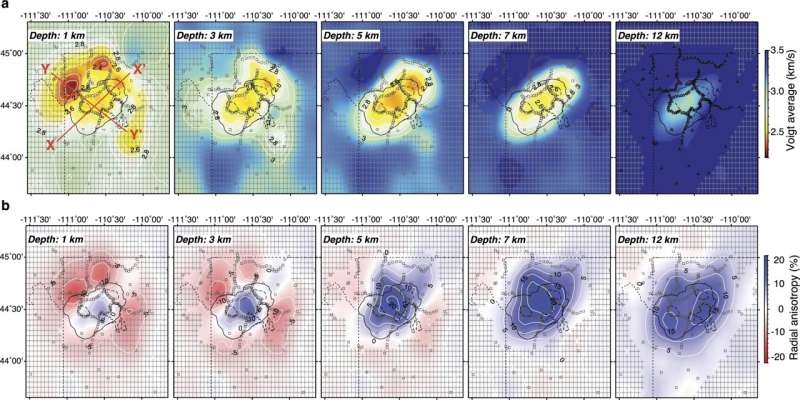July 5, 2023 report
This article has been reviewed according to Science X's editorial process and policies. Editors have highlighted the following attributes while ensuring the content's credibility:
fact-checked
peer-reviewed publication
trusted source
proofread
New measurement of Yellowstone magma reservoir suggests upper part is 28% melted rock

A small team of geologists and seismologists from the University of Utah, Salt Lake, the Institute of Earth Sciences, Academia Sinica, Taipei and the University of New Mexico has studied the content of the Yellowstone magma reservoir and reports differences from prior measurements. In their study, reported in the journal Earth and Planetary Science Letters, the group used seismic wave data to better understand the conditions beneath Yellowstone National Park.
Yellowstone National Park is a U.S. national park located in parts of Wyoming, Montana and Idaho. It is known for its beautiful vistas and geothermal features, such as the Old Faithful geyser. These features exist due to a massive reservoir of magma situated beneath the park. Prior research has shown that over the past 16.5 million years, the hotspot beneath the park has led to a series of volcanic eruptions, leaving behind multiple calderas. The last major eruption in the area is believed to have occurred approximately 640,000 years ago.
Over the years, many teams of researchers have studied the Yellowstone magma reservoir and have found ways to measure its size and make predictions about its content. The upper part of the reservoir is roughly 90 kilometers long and 40 kilometers wide. Beneath the upper reservoir is a lower chamber that is believed to be approximately 4.5 times that size.
Prior study of both chambers has suggested that the deeper reservoir is made of mostly solid material mixed with 2% melt. The upper chamber, on the other hand, has much more melt—prior to this new effort, researchers estimated between16 and 20% melt.
In this new effort, the researchers found the percentage to be somewhat higher. After analyzing seismic wave data, they found it to be approximately 28% melt. The percentage of melt in a magma reservoir is important because it can offer clues about the possibility of an eruption. In this instance, the new team is in agreement with prior assessments showing that there is little risk of an imminent eruption anywhere in the park.
More information: Sin-Mei Wu et al, Extreme seismic anisotropy indicates shallow accumulation of magmatic sills beneath Yellowstone caldera, Earth and Planetary Science Letters (2023). DOI: 10.1016/j.epsl.2023.118244
Journal information: Earth and Planetary Science Letters
© 2023 Science X Network




















